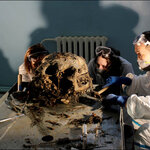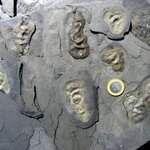Paleontology

A human ancestor
dated to 1.34 million years old and belonging to Paranthropus boisei at the Olduvai Gorge World Heritage fossil site in Tanzania
is characterized by a "robust" jaw and skull bones and was a muscular creature with a gorilla-like upper body and more adaptive to its environment than previously thought, scientists have discovered.
The partial skeleton -- including arm, hand, leg and foot fragments -- represents one of the most recent occurrences of P. boisei before its extinction in East Africa.
"This is the first time we've found bones that suggest that this creature was more…

As someone who works on Silurian age fossils, I can't help but be jealous every time a new mammoth "fossil" is found in permafrost. I'm using quotation marks here around because these mammoth corpses can barely be considered to be fossils. My fossils are traces of rock on rock. Whereas, these mammoth corpses are so fresh, the discoverers have problems keeping their dogs from tucking in.
My most recent pang of jealousy occurred on finding out that Yuka, one of the more famed frozen mammoth corpses is to have her brain scanned. What I would give to be able to have an intact brain in any of my…

A new species of tyrannosaur, Lythronax Argestes, has been unearthed in Grand Staircase-Escalante National Monument in southern Utah. Lythronax translates as "king of gore," and the second part of the name, argestes, refers to its geographic location in the American Southwest.
The huge carnivore inhabited Laramidia, a landmass formed on the western coast of a shallow sea that flooded the central region of North America, isolating western and eastern portions of the continent for millions of years during the Late Cretaceous Period, between 95-70 million years ago.
The newly discovered…

A high school student is credited with finding the youngest, smallest and most complete fossil skeleton yet known from the iconic tube-crested dinosaur Parasaurolophus, in Grand Staircase-Escalante National Monument in southern Utah.
The discovery shows that the prehistoric plant-eater sprouted its strange headgear before it celebrated its first birthday. Three-dimensional scans of nearly the entire fossil make this the most digitally accessible dinosaur to date.
The new fossil shows that baby Parasaurolophus had a low bump on top of its head, which only later morphed into the…

Oxygen was essential for advanced life to evolve; ancient dinosaurs and modern large-brained mammals needed a lot of oxygen to keep their large and sophisticated organisms running. Some simple organisms like bacteria can survive without oxygen, but all higher organisms need it our atmosphere's 21 percent oxygen is essential for the human brain to function.
So why did life not explode when oxygen levels rose dramatically 2.1 billion years ago? The oxygen content 2.1 billion years ago was probably the same as when life exploded around 542 million years ago - the Cambrian explosion…

The fifth skull to be discovered in Dmanisi displays a combination of features unknown to researchers before the find - the largest face, the most massively built jaw and teeth and the smallest brain within the Dmanisi group.
Previously, four equally well-preserved hominid skulls as well as some skeletal parts had been found there. Taken as a whole, the finds show that the first representatives of the genus Homo began to expand from Africa through Eurasia as far back as 1,850,000 years ago.
Because the skull is completely intact, it can provide answers to various questions which up until now…

Because an uninterrupted sequence of fossilized pollen from flowers begins in the Early Cretaceous, approximately 140 million years ago, it is generally assumed that flowering plants first evolved around that time.
A new study documents flowering plant-like pollen that is 100 million years older, implying that flowering plants may have originated in the Early Triassic (between 252 to 247 million years ago) or even earlier. Flowering plants evolved from extinct plants related to conifers, ginkgos, cycads, and seed ferns.
Many studies have tried to estimate the age of…

The discovery of what may be the earliest known creature with what can be discerned as a face has been reported in Nature. Entelognathus primordialis is an exceptionally well-preserved 419-million-year-old fish from China that is the most primitive vertebrate to have a modern type of jaw.
This fish is a placoderm, one of a member of an extinct group of gnathostomes (jawed vertebrates), but its jaw is much more like that of a modern bony fish: its discovery may offer a new perspective on the early evolution of these creatures.
The evolution of jaws is one of the key episodes in the evolution…

A new species called Gondwanascorpio emzantsiensis is now the oldest known land-living animal discovered in Gondwana. Dr. Robert Gess, from the Evolutionary Studies Institute at Wits University, discovered the 350 million year old fossilized scorpion from rocks of the Devonian Witteberg Group near Grahamstown.
Explaining his discovery, Gess said that early life was confined to the sea and the process of terrestrialization - the movement of life onto land - began during the Silurian Period roughly 420 million years ago. The first wave of life to move out from water onto land consisted of…

A 160 million-year-old fossil of an extinct rodent-like creature from China has been identified as Rugosodon eurasiaticus and is helping to explain how multituberculates, the most evolutionarily successful and long-lived mammalian lineage in the fossil record, achieved their dominance.
Rugosodon eurasiaticus is currently the oldest ancestor in the multituberculate family tree. The nearly complete skeleton provides critical insights into the traits that helped such multituberculates thrive in their day. For example, the fossil reveals teeth that were adapted to gnawing plants and animals alike…